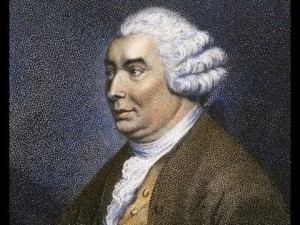Causation
 The medieval synthesis Thomas Aquinas (1224–74) forged between Christian theology and Aristotle’s science and metaphysics set the terms for the early modern causation debate. Aristotle (384–322 BCE) drew an absolute categorical distinction between scientific knowledge (scientia) and belief (opinio). Scientific knowledge was knowledge of causes and scientific explanation consisted in demonstration—proving the necessary connection between a cause and its effect from intuitively obvious premises independently of experience.
The medieval synthesis Thomas Aquinas (1224–74) forged between Christian theology and Aristotle’s science and metaphysics set the terms for the early modern causation debate. Aristotle (384–322 BCE) drew an absolute categorical distinction between scientific knowledge (scientia) and belief (opinio). Scientific knowledge was knowledge of causes and scientific explanation consisted in demonstration—proving the necessary connection between a cause and its effect from intuitively obvious premises independently of experience.
Modern philosophers thought of themselves as scientific revolutionaries because they rejected Aristotle’s account of causation. Even so, they accepted his distinction between knowledge and belief, and regarded causal inference as an exercise of reason, which aimed at demonstrating the necessary connection between cause and effect. Malebranche (1638–1715), and others following Descartes (1596–1650), were optimistic about the possibility of demonstrative scientific knowledge, while those in the British experimental tradition were more pessimistic. Locke was sufficiently sceptical about what knowledge we can attain that he constructed one of the first accounts of probable inference to show that belief can meet standards of rationality that make experimental natural philosophy intellectually respectable.
When Hume enters the debate, he translates the traditional distinction between knowledge and belief into his own terms, dividing “all the objects of human reason or enquiry” into two exclusive and exhaustive categories: relations of ideas and matters of fact.
Propositions concerning relations of ideas are intuitively or demonstratively certain. They are known a priori—discoverable independently of experience by “the mere operation of thought”, so their truth doesn’t depend on anything actually existing. That the interior angles of a Euclidean triangle sum to 180 degrees is true whether or not there are any Euclidean triangles to be found in nature. Denying that proposition is a contradiction, just as it is contradictory to say that 8×7=57.
In sharp contrast, the truth of propositions concerning matters of fact depends on the way the world is. Their contraries are always possible, their denials never imply contradictions, and they can’t be established by demonstration. Asserting that Miami is north of Boston is false, but not contradictory. We can understand what someone who asserts this is saying, even if we are puzzled about how he could have the facts so wrong.
The distinction between relations of ideas and matters of fact is often called “Hume’s Fork”, and is generally used with the negative implication that Hume may be illicitly ruling out meaningful propositions that don’t fit into these two categories or fit into both of them. To defuse this objection, however, it is important to bear in mind that Hume’s categories are his translations of a traditional absolute categorical classificatory distinction between knowledge and belief that all of his contemporaries and immediate predecessors accepted.
Hume’s method dictates his strategy in the causation debate. In the critical phase, he argues that his predecessors were wrong: our causal inferences aren’t determined by “reason or any other operation of the understanding”. In the constructive phase, he supplies an alternative: the associative principles are their basis.
 Causal Inference: Critical Phase
Causal Inference: Critical Phase
Causal inferences are the only way we can go beyond the evidence of our senses and memories. In making them, we suppose there is some connection between present facts and what we infer from them. But what is this connection? How is it established?
If the connection is established by an operation of reason or the understanding, it must concern either relations of ideas or matters of fact.
Hume argues that the connection can’t involve relations of ideas. Effects are different events from their causes, so there is no contradiction in conceiving of a cause occurring, and its usual effect not occurring. Ordinary causal judgments are so familiar that we tend to overlook this; they seem immediate and intuitive. But suppose you were suddenly brought into the world as an adult, armed with the intellectual firepower of an Einstein. Could you, simply by examining an aspirin tablet, determine that it will relieve your headache?
When we reason a priori, we consider the idea of the object we regard as a cause independently of any observations we have made of it. It can’t include the idea of any other distinct object, including the object we take to be its usual effect. But then it can’t show us any “inseparable and inviolable connection”—any necessary connection—between those ideas. Trying to reason a priori from your idea of an aspirin, without including any information you have of its effects from your previous experience, yields only the simple ideas that compose your idea of its “sensible qualities”—its size, shape, weight, color, smell, and taste. It gives you no idea of what “secret powers” it might have to produce its usual effects. Hume concludes that a priori reasoning can’t be the source of the connection between our ideas of a cause and its effect. Contrary to what the majority of his contemporaries and immediate predecessors thought, causal inferences do not concern relations of ideas.
Hume now moves to the only remaining possibility. If causal inferences don’t involve a priori reasoning about relations of ideas, they must concern matters of fact and experience. When we’ve had many experiences of one kind of event constantly conjoined with another, we begin to think of them as cause and effect and infer the one from the other. But even after we’ve had many experiences of a cause conjoined with its effect, our inferences aren’t determined by reason or any other operation of the understanding.
In the past, taking aspirin has relieved my headaches, so I believe that taking aspirin will relieve the headache I’m having now. But my inference is based on the aspirin’s superficial sensible qualities, which have nothing to do with headache relief. Even if I assume that the aspirin has “secret powers” that are doing the heavy lifting in relieving my headache, they can’t be the basis of my inference, since these “secret powers” are unknown.
Nonetheless, Hume observes, “we always presume, when we see like sensible qualities, that they have like secret powers, and expect that effects, similar to those we have experienced, will follow from them”. Since we neither intuit nor infer a priori that similar objects have similar secret powers, our presumption must be based in some way on our experience.
But our past experience only gives us information about objects as they were when we experienced them, and our present experience only tells us about objects we are experiencing now. Causal inferences, however, do not just record our past and present experiences. They extend or project what we have gathered from experience to other objects in the future. Since it is not necessarily true that an object with the same sensible qualities will have the same secret powers that past objects with those sensible qualities had, how do we project those experiences into the future, to other objects that may only appear similar to those we’ve previously experienced?
Hume thinks we can get a handle on this question by considering two clearly different propositions:
- I’ve found that headache relief has always followed my taking aspirin; and
- Taking aspirin similar to the ones I’ve taken in the past will relieve my present headache.
There is no question that “the one proposition may be justly inferred from the other”, and that “it is always inferred”. But since their connection obviously isn’t intuitive, Hume challenges us to produce the “chain of reasoning” that takes us from propositions like (1) to propositions like (2).
(1) summarizes my past experience, while (2) predicts what will happen in the immediate future. The chain of reasoning I need must show me how my past experience is relevant to my future experience. I need some further proposition or propositions that will establish an appropriate link or connection between past and future, and take me from (1) to (2) using either demonstrative reasoning, concerning relations of ideas, or probable reasoning, concerning matters of fact.
Hume thinks it is evident that demonstrative reasoning can’t bridge the gap between (1) and (2). However unlikely it may be, we can always intelligibly conceive of a change in the course of nature. Even though aspirin relieved my previous headaches, there’s no contradiction in supposing that it won’t relieve the one I’m having now, so the supposition of a change in the course of nature can’t be proven false by any reasoning concerning relations of ideas.
That leaves probable reasoning. Hume argues that there is no probable reasoning that can provide a just inference from past to future. Any attempt to infer (2) from (1) by a probable inference will be viciously circular—it will involve supposing what we are trying to prove.
Hume spells out the circularity this way. Any reasoning that takes us from (1) to (2) must employ some connecting principle that connects the past with the future. Since one thing that keeps us from moving directly from past to future is the possibility that the course of nature might change, it seems plausible to think that the connecting principle we need will assure us that nature is uniform—that the course of nature won’t change—something like the uniformity principle:
[UP] The future will be like the past.
Adopting [UP] will indeed allow us to go from (1) to (2). But before we can use it to establish that our causal inferences are determined by reason, we need to determine our basis for adopting it. [UP] is clearly not intuitive, nor is it demonstrable, as Hume has already pointed out, so only probable arguments could establish it. But to attempt to establish [UP] this way would be to try to establish probable arguments using probable arguments, which will eventually include [UP] itself.
Hume has exhausted the ways reason might establish a connection between cause and effect to show that our causal inferences are based on reason. He assures us that he offers his “skeptical doubts” not as a “discouragement, but rather an incitement … to attempt something more full and satisfactory”. Having cleared the way for his constructive account, Hume is ready to do just that.
Causal Inference: Constructive Phase
Hume calls his constructive account of causal inference a “sceptical solution” to the “sceptical doubts” he raised in the critical phase of his argument.
Since we’re determined—caused —to make causal inferences, then if they aren’t “determined by reason”, there must be “some principle of equal weight and authority” that leads us to make them. Hume maintains that this principle is custom or habit:
“Whenever the repetition of any particular act or operation produces a propensity to renew the same act or operation … we always say, that this propensity is the effect of Custom.”
It is therefore custom, not reason, which “determines the mind … to suppose the future conformable to the past”. But even though we have located the principle, it is important to see that this isn’t a new principle by which our minds operate. Custom and habit are general names for the principles of association.
Hume describes their operation as a causal process: custom or habit is the cause of the particular propensity you form after your repeated experiences of the constant conjunction of smoke and fire. Causation is the operative associative principle here, since it is the only one of those principles that can take us beyond our senses and memories.
Hume concludes that custom alone “makes us expect for the future, a similar train of events with those which have appeared in the past”. Custom thus turns out to be the source of the Uniformity Principle—the belief that the future will be like the past.
Belief
Causal inference leads us not only to conceive of the effect, but also to expect it. When I expect that the aspirin will relieve my headache, I’m not just abstractly considering the idea of headache relief, I believe that the aspirin will relieve it. What more is involved in believing that aspirin will relieve my headache than in merely conceiving that it will?
It can’t be that beliefs have some additional idea—the idea of belief, perhaps—that conceptions lack. If there were some such idea, given our ability to freely combine ideas, we could, by simply willing, add that idea to any conception whatsoever, and believe anything we like.
Hume concludes that belief must be some sentiment or feeling aroused in us independently of our wills, which accompanies those ideas that constitute them. It is a particular way or manner of conceiving an idea that is generated by the circumstances in which we find ourselves.
If constant conjunctions were all that is involved, my thoughts about aspirin and headaches would only be hypothetical. For belief, one of the conjoined objects must be present to my senses or memories; I must be taking, or just have taken, the aspirin. In these circumstances, believing that my headache will soon be relieved is as unavoidable as feeling affection for a close friend, or anger when someone harms us. “All these operations are species of natural instincts, which no reasoning … is able either to produce or prevent”.
While Hume thinks that defining this sentiment may be impossible, we can describe belief, if only by analogy, although he was never completely satisfied with his attempts to do so. Belief is a livelier, firmer, more vivid, steady, and intense conception of an object. Hume intends these characterizations to go beyond merely recording intensity of feeling to capture how belief renders realities … more present to us than fictions, causes them to weigh more in the thought, and gives them a superior influence on the passions and imagination.
But how does an idea come to be conceived in such a manner that it constitutes a belief?
Hume’s explanation is that as I become accustomed to aspirin’s relieving my headaches, I develop a propensity—a tendency—to expect headache relief to follow taking aspirin. The propensity is due to the associative bond that my repeated experiences of taking aspirin and headache relief have formed. My present impressions of taking an aspirin are as forceful and vivid as anything could be, and some of their force and vivacity transfers across the associative path to the idea of headache relief, enlivening it with enough force and vivacity to give it the “strength and solidity” that constitutes belief.
Since I don’t know how aspirin relieves headaches, it is fortunate that there is “a kind of pre-established harmony between the course of nature and the succession of our ideas” that teaches me to take aspirin when I have a headache. Custom, Hume maintains, in language that anticipates and influenced Darwin,
is that principle by which this correspondence has been effected; so necessary to the subsistence of our species, and the regulation of our conduct, in every circumstance of human life.
It is far better, Hume concludes, to rely on “the ordinary wisdom of nature”, which ensures that we form beliefs “by some instinct or mechanical tendency”, rather than trusting it to “the fallacious deductions of our reason”.
In keeping with his project of providing a naturalistic account of how our minds work, Hume has given empirical explanations of our propensity to make causal inferences, and the way those inferences lead to belief.
Source: http://plato.stanford.edu/entries/hume/